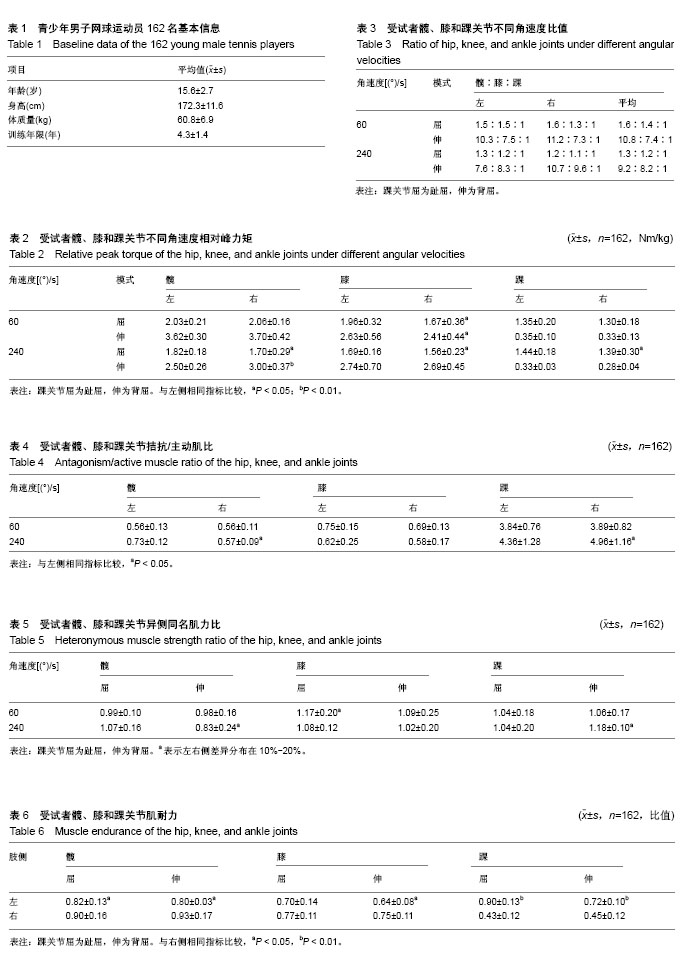中国组织工程研究 ›› 2018, Vol. 22 ›› Issue (24): 3798-3800.doi: 10.3969/j.issn.2095-4344.0314
• 肌肉肌腱韧带组织构建 tissue construction of the muscle, tendon and ligament • 上一篇 下一篇
等速肌力测试单关节或关节链不同运动模式以及运动角速度下的肌力参数
米思奇1,钱 莉2
- 1阿坝师范学院,四川省汶川县 623002;2四川省运动技术学院康复中心,四川省成都市 610041
Muscle strength parameters of single joint or joint chain under different motion modes and angular velocities by isokinetic muscle test
Mi Si-qi1, Qian Li2
- 1Aba Teachers University, Wenchuan 623002, Sichuan Province, China; 2Rehabilitation Center of Sichuan Provincial Sports Technology Institute, Chengdu 610041, Sichuan Province, China
摘要:
文章快速阅读:
.jpg) 文题释义:
等速肌力:利用等速肌力测试仪测量受试者单关节或关节链不同运动模式以及运动角速度下的肌力参数。
拮抗/主动肌比:指关节运动时拮抗肌与主动肌峰力矩的比值,该研究指屈肌与伸肌峰力矩比值,反映关节运动时拮抗肌与主动肌比例,对判断关节稳定性、预防损伤有指导意义。
异侧同名肌力比:指左右侧同关节相同运动功能肌群的峰力矩比值,该研究为左侧/右侧。研究认为<10%为正常范围,> 20%有临床意义会增加由于双侧肌力不平衡导致的损伤风险。
肌肉耐力:该研究以240 (°)/s测试中21-25次关节运动做功与1-5次做功的比值来衡量肌肉耐力,接近1说明肌群耐力越好。
文题释义:
等速肌力:利用等速肌力测试仪测量受试者单关节或关节链不同运动模式以及运动角速度下的肌力参数。
拮抗/主动肌比:指关节运动时拮抗肌与主动肌峰力矩的比值,该研究指屈肌与伸肌峰力矩比值,反映关节运动时拮抗肌与主动肌比例,对判断关节稳定性、预防损伤有指导意义。
异侧同名肌力比:指左右侧同关节相同运动功能肌群的峰力矩比值,该研究为左侧/右侧。研究认为<10%为正常范围,> 20%有临床意义会增加由于双侧肌力不平衡导致的损伤风险。
肌肉耐力:该研究以240 (°)/s测试中21-25次关节运动做功与1-5次做功的比值来衡量肌肉耐力,接近1说明肌群耐力越好。
.jpg) 文题释义:
等速肌力:利用等速肌力测试仪测量受试者单关节或关节链不同运动模式以及运动角速度下的肌力参数。
拮抗/主动肌比:指关节运动时拮抗肌与主动肌峰力矩的比值,该研究指屈肌与伸肌峰力矩比值,反映关节运动时拮抗肌与主动肌比例,对判断关节稳定性、预防损伤有指导意义。
异侧同名肌力比:指左右侧同关节相同运动功能肌群的峰力矩比值,该研究为左侧/右侧。研究认为<10%为正常范围,> 20%有临床意义会增加由于双侧肌力不平衡导致的损伤风险。
肌肉耐力:该研究以240 (°)/s测试中21-25次关节运动做功与1-5次做功的比值来衡量肌肉耐力,接近1说明肌群耐力越好。
文题释义:
等速肌力:利用等速肌力测试仪测量受试者单关节或关节链不同运动模式以及运动角速度下的肌力参数。
拮抗/主动肌比:指关节运动时拮抗肌与主动肌峰力矩的比值,该研究指屈肌与伸肌峰力矩比值,反映关节运动时拮抗肌与主动肌比例,对判断关节稳定性、预防损伤有指导意义。
异侧同名肌力比:指左右侧同关节相同运动功能肌群的峰力矩比值,该研究为左侧/右侧。研究认为<10%为正常范围,> 20%有临床意义会增加由于双侧肌力不平衡导致的损伤风险。
肌肉耐力:该研究以240 (°)/s测试中21-25次关节运动做功与1-5次做功的比值来衡量肌肉耐力,接近1说明肌群耐力越好。摘要
背景:目前对网球运动员等速肌力测试,集中在成年网球运动员,测试部位多为肩关节或单个关节,缺乏大样本针对青少年男子网球运动员下肢关节不同角速度等速肌力的报道。
目的:分析青少年男子网球运动员下肢关节肌力特征,分析不同角速度测试数据变化规律。
方法:德国产IsoMed 2000 等速肌力测试仪,对162名青少年男子网球运动员双侧髋、膝和踝关节进行屈伸模式等速肌力测试:60 (°)/s(绝对力)5次,240 (°)/s(爆发力)25次。受试者左、右侧相对峰力矩、拮抗/主动肌比、异侧同名肌力比和肌耐力参数进行配对样本t检验。
结果与结论:①相对峰力矩:髋关节左侧屈肌爆发力显著大于右侧(P < 0.05),右侧伸肌爆发力非常显著大于左侧(P < 0.01);膝关节左侧屈、伸绝对力和屈肌爆发力显著大于右侧(P < 0.05);踝关节左侧屈肌爆发力显著大于右侧(P < 0.05);②下肢不同角速度峰力矩比值:髋、膝和踝关节屈肌绝对力比值为1.6∶1.4∶1;伸肌绝对力比值为10.8∶7.4∶1;屈肌爆发力为1.3∶1.2∶1;伸肌爆发力为9.2∶8.2∶1;③拮抗/主动肌比:绝对力测试中髋、膝和踝关节分别为0.56,0.73和3.86;爆发力测试中髋、膝和踝关节分别为0.65,0.60和4.66;髋和踝关节左右侧爆发力差异有显著性意义(P < 0.05);④下肢异侧同名肌力比:差异在10%-20%为的膝关节屈肌绝对力,髋和踝伸肌爆发力;⑤下肢肌肉耐力水平:左、右髋关节的屈、伸肌群耐力比较,左、右膝关节伸肌群耐力比较差异有显著性意义(P < 0.05);左右踝关节屈、伸肌群耐力比较差异有非常显著性意义(P < 0.01);⑥结论:随着测试角速度的增加,青少年男子网球运动员双侧髋、膝和踝关节屈、伸相对峰力矩减小,下肢屈伸肌相对峰力矩表现为髋>膝>踝;青少年男子网球运动员,踝关节快速伸的爆发能力变化较髋、膝关节大。髋、踝关节屈伸爆发力的异侧同名肌力差异显著,建议加强右侧髋关节屈肌爆发力练习;青少年男子网球运动员髋关节屈伸耐力相对较好,建议增加踝关节伸肌、膝关节屈伸肌耐力练习。
中国组织工程研究杂志出版内容重点:组织构建;骨细胞;软骨细胞;细胞培养;成纤维细胞;血管内皮细胞;骨质疏松;组织工程
ORCID: 0000-0002-7455-9531(米思奇)
中图分类号:

.jpg) 文题释义:
等速肌力:利用等速肌力测试仪测量受试者单关节或关节链不同运动模式以及运动角速度下的肌力参数。
拮抗/主动肌比:指关节运动时拮抗肌与主动肌峰力矩的比值,该研究指屈肌与伸肌峰力矩比值,反映关节运动时拮抗肌与主动肌比例,对判断关节稳定性、预防损伤有指导意义。
异侧同名肌力比:指左右侧同关节相同运动功能肌群的峰力矩比值,该研究为左侧/右侧。研究认为<10%为正常范围,> 20%有临床意义会增加由于双侧肌力不平衡导致的损伤风险。
肌肉耐力:该研究以240 (°)/s测试中21-25次关节运动做功与1-5次做功的比值来衡量肌肉耐力,接近1说明肌群耐力越好。
文题释义:
等速肌力:利用等速肌力测试仪测量受试者单关节或关节链不同运动模式以及运动角速度下的肌力参数。
拮抗/主动肌比:指关节运动时拮抗肌与主动肌峰力矩的比值,该研究指屈肌与伸肌峰力矩比值,反映关节运动时拮抗肌与主动肌比例,对判断关节稳定性、预防损伤有指导意义。
异侧同名肌力比:指左右侧同关节相同运动功能肌群的峰力矩比值,该研究为左侧/右侧。研究认为<10%为正常范围,> 20%有临床意义会增加由于双侧肌力不平衡导致的损伤风险。
肌肉耐力:该研究以240 (°)/s测试中21-25次关节运动做功与1-5次做功的比值来衡量肌肉耐力,接近1说明肌群耐力越好。